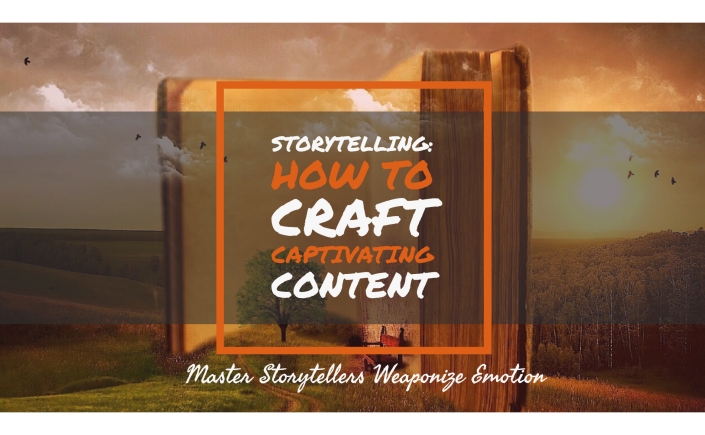Storytelling is an escape of the mind. It offers us the opportunity to see the world through the eyes of another. It’s a vehicle through which influence can be asserted, mountains climbed and dragons slain. Tales of adversity and triumph stay with us, shaping our expectations of the world. We are David facing off against the Philistine giant Goliath in the heat of afternoon sun. Armed with little more than a shepherd’s staff, a sling shot and a little bag of stones, we step into the battle arena and confront our foe. Facing our Goliath requires courage and unwavering trust in ourselves.
“A master storyteller knows how to hook readers with emotive content.”
We take our little slingshot and wait as the giant lumbers towards us, his mighty sword glistening with the blood of a thousand Israelites. A bead of sweat trickles down our brow, and yet we wait. Just as Goliath swings his sword, we take a stone from our pouch, load up our slingshot and aim. Fire! Thud! Our slingshot has found a chink in the giant’s armour. We grab the giant’s mighty sword, pirouette and bring it crashing down upon his head. Goliath is no more.
David and Goliath as the Archetypal ‘Overcoming the Monster’ Hero’s Journey
David’s triumph against the mighty Goliath resonates because people choose to believe that ultimately, we can overcome our limitations. We champion the underdog because we can see ourselves in him. We will him to succeed against all the odds, because through him, we too can succeed.
Malcolm Gladwell’s fascinating book ‘David and Goliath: Underdogs, Misfits, and the Art of Battling Giants’ expands upon this, taking it to new heights, heights which suggest we’ve all profoundly misunderstood the situation.
For Gladwell, the balance of power needs to be re-examined. David didn’t meet Goliath on the expected terms, laden with heavy armour and a wieldy sword. David redefined the terms of the fight, choosing instead to play to his own strengths. In doing so, another tool in a storyteller’s arsenal is invoked.
David’s perceived limitations causes the Philistines to dismiss him. His chances of winning are deemed dim at best. David is cast as the underdog- short in stature but brave of heart. Goliath is his adversary, an obstacle that needs to be overcome. The juxtaposition between our unlikely hero and his fearsome opponent strikes fear into the heart of the reader. What if David doesn’t defeat his foe? What happens if he fails? And so, opposition and danger are seamlessly woven into our tale.
Master Storytelling: Weaponize the Power of Emotion
The woes of the Israelites become real to us, contextualised by our newfound connection to David, our protagonist. The reader becomes invested in the plot and in David’s well-being. Now that the story setting, source of conflict and plot have been established, it’s crucial our story arcs and builds to a climax. By protecting his people from the lumbering giant Goliath and his Philistine brethren, our protagonist, David carries out a morally significant action.
“Storytelling is an escape of the mind. It offers us the opportunity to see the world through the eyes of another. It’s a vehicle through which influence can be asserted, mountains climbed and dragons slain”
Upon witnessing the slaying of their kin, the other Philistines turn tail and run for the hills, vowing to never attack the Israelites again. Justice is done and the balance of good and evil has once again been restored. David’s unlikely triumph provides the reader with a sense of cathartic relief. Commonly cited in Aristotle’s Poetics, catharsis is understood to be a release or purging of negative emotions.
Master storytellers weaponize emotion. Think about how you feel when justice prevails or when Sea-biscuit overcame his injury to win the Grand National after his owners are told he’d never race again. Catharsis makes content memorable. The feelings and emotions familiar story plots evoke, release powerful brain chemicals like cortisol and dopamine. The story of David and Goliath is the archetypal ‘overcoming the monster’ hero’s journey, and it’s one that resonates with people.
Good Storytelling is Good the World Over
If you want to create captivating content your primary goal should be to evoke emotion. A great storyteller knows how to hook readers with emotive content. Bring your readers on a journey with you: place obstacles in front of your characters-contrived or otherwise, obstacles help further character development-give your protagonist or antagonist a fatal flaw, and always give your readers a sense of closure. Catharsis is a powerful weapon and negating to utilise it can destroy an otherwise beautifully crafted story.
“We champion the underdog because we can see ourselves in him. We will him to succeed against all the odds, because through him, we too can succeed.”
Good storytelling is good storytelling the world over. It doesn’t matter of you’re creating a business proposal, writing a LinkedIn blog or a job description. Make each and ever word count by creating an emotional hook that will make your content memorable. Ditch the PowerPoint presentations (sorry Microsoft!), create a captivating headline, add a keyword-friendly subhead if you like, use eye-catching images, infographics or videos where relevant and don’t ever be afraid to let your personality shine through. We can all learn a lot from the story of David and his Goliath.


[…] to draw up a brand voice chart. Think of the customer demographic you’re trying to appeal to. What story are you trying to tell? Is a funny or irreverent tone suitable for a big bank or an insurance company? The answer may […]
LikeLike
[…] then, the Coca-Cola brand has been inextricably linked with American culture. It has been instrumental in creating cultural artefacts and memorable campaigns, most notably their Christmas campaigns which have become an institution in their own […]
LikeLike